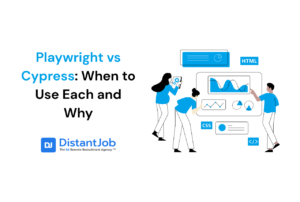Node.js is one of the most reliable software to scale a growing business. It’s the best option for tech leaders such as Uber and eBay. Simply because it allows building complex mobile apps using simple lines of code. Despite the software is widely used worldwide, Node.js security is something your developer needs to take into account.
Like any other framework or programming language, Node.js can be affected by different web application vulnerabilities. The core of the framework remains untouched, but third-party packages require additional security measures. GitHub estimates that 14% of the Node Package Manager (NPM) ecosystem is affected. Meanwhile, the indirectly affected packages are almost 54% of the ecosystem.
Besides these security issues, 51% of programmers use Node.js instead of other frameworks and tools. Therefore, Node.js remains one of the most reliable options to scale global and growing businesses with multiple databases. As it is written in JavaScript, programmers can handle several databases and requests simultaneously with just a few lines of code.
While Node.js provides a solid foundation for building efficient applications, it’s crucial to adopt best practices that fortify your app against potential vulnerabilities.
Let’s delves into the essential security measures and practices that are key to safeguarding your Node.js applications
1. Mitigating XSS Attacks and Securing User Inputs
Cross-Site Scripting (XSS) represents one of the most common security threats to web applications. In XSS attacks, hackers inject malicious client-side scripts into your website’s pages, which other users can then unwittingly view. These scripts can lead to significant data breaches, compromising both your application’s integrity and user trust.
Moreover, attackers often use JavaScript to manipulate or invalidate user inputs, further exploiting vulnerabilities.
To counter this security challenge in Node.js applications, the first line of defense is robust validation of user input. It’s essential to ensure that all incoming data is thoroughly checked and sanitized before it’s processed or stored. Implementing output encoding techniques is another effective strategy. This involves converting potentially harmful input into a safe format, neutralizing the threat posed by malicious scripts.
Several tools and frameworks can assist in bolstering your application against XSS attacks. For instance, utilizing frameworks with built-in encoding capabilities can significantly reduce the risk. Additionally, integrating XSS filters or libraries like Validatorjs into your system can provide an extra layer of security, helping to automatically detect and mitigate XSS vulnerabilities.
2. Prevent Data Leaks
Data leaks pose a significant risk in web development, and Node.js applications are no exception. In Node.js, it’s common to transmit a substantial amount of data related to an object from the back-end to the front-end. This process often involves sending more information than what is eventually displayed to the user. While this approach can be convenient for development, it inadvertently creates opportunities for data exposure.
Hackers are adept at uncovering hidden data that the back-end transmits. They can exploit this excess data to gain unauthorized access to sensitive information. To mitigate this risk, it’s crucial to adopt a ‘minimal data’ strategy. This means that your application should only send the absolute necessary information to the front-end. For instance, in a user profile context, limit the transmitted data to essentials like the first name and last name, and exclude any sensitive details that aren’t required for the specific functionality.
Implementing this practice requires a careful review of the data your application sends to the front-end. Regularly auditing this data flow can help identify and eliminate potential areas where unnecessary data is transmitted.
By sending only what is needed, you significantly reduce the risk of data leaks, protecting both your users’ privacy and your application’s security.
3. Leverage Security Linters for Proactive Protection
Node.js offers powerful tools for proactively identifying and addressing security vulnerabilities. One of the key advantages of Node.js is its ability to automatically scan for security weaknesses. Moreover, it enables developers to catch potential security issues right at the source – during the code writing process itself.
To harness this capability effectively, developers can integrate specialized linter plugins into their development environment. A linter is a tool that analyzes code for potential errors, stylistic issues, and security vulnerabilities. For Node.js, plugins like eslint-plugin-security are particularly valuable. They are designed to detect and alert developers about insecure coding practices as they write the code.
With security linters, developers can significantly reduce the risk of security flaws being introduced into the application. These tools provide immediate feedback, allowing for the swift correction of any issues. This not only streamlines the development process but also ensures that the codebase remains robust and secure from the ground up.
4. Implement Access Control
Another Node.js security issue relates to user permissions to various URLs or areas. For example, if you have limited app areas like the admin dashboard where users can access without role, you have access exposure.
The most common solution for this security issue is manually testing app modules that require special user permissions. Middle and access control rules work better on the server-side because they reduce the room for manipulating access permissions from the client-side. Secondly, set up log access controlling and API rate restricting must be set up to alert the admin of possible attacks.
5. Secure Deserialization: Guard Against CSRF Attacks in Node.js
Another Node.js vulnerability is insecure deserialization., often leading to Cross-Site Request Forgery (CSRF) attacks. CSRF is a deceptive attack where unsuspecting users are coerced into executing unintended actions on legitimate websites. This type of attack exploits the trust a web application has in the authenticated user, manipulating it to perform unauthorized actions.
Attackers frequently use social engineering tactics, such as deceptive emails or chat messages, to trick users into executing these actions unknowingly. The consequences of CSRF attacks can range from benign to severe, potentially compromising user data and application integrity.
To combat this, Node.js supports the implementation of anti-forgery tokens, a robust defense mechanism against CSRF attacks. These tokens are unique to each user session and request, ensuring that the actions performed are genuinely initiated by the authenticated user. By integrating anti-forgery tokens into your Node.js applications, you can significantly diminish the risk of CSRF attacks. This method effectively verifies the authenticity of user requests, preventing attackers from exploiting the deserialization process.
Employing anti-forgery tokens is a proactive step towards enhancing the security of your Node.js applications. It not only safeguards your users from malicious activities but also maintains the integrity and trustworthiness of your web platform.
6. HTTP Response Headers
Express is one of the most popular Node.js web app frameworks. Like Node, Express needs some security considerations. With this framework, your developer needs to maintain and update versions to implement security. It’s possible to reduce external attacks by adding security-related HTTP headers to your apps, like CORS or Helmet.
7. Logging and Monitoring
Logging and monitoring are the most popular issues associated with Node.js security. Hackers can make your app unavailable and hide the logging. By monitoring logs and metrics, it is possible to redirect the users interactions of different pages or track the wrong input. There are different tools to add distinct layers to implement your system security depending on the data amount. Through data, it’s possible to asset and identify exposures and invasions.
8. Ensure Robust Authentication in Node.js
A critical aspect of securing Node.js applications is establishing a robust and complete authentication system. Incomplete or improperly implemented authentication can lead to severe security vulnerabilities, leaving your application exposed to unauthorized access and potential data breaches.
To fortify the authentication process, developers have a range of reliable solutions at their disposal. Options such as OAuth, Firebase Authentication, Auth0, or Okta offer sophisticated and tested mechanisms for user authentication. These platforms provide a higher level of security, often incorporating features like two-factor authentication (2FA) and single sign-on (SSO), thereby enhancing the overall security posture of your application.
When dealing with passwords, it’s advisable to steer clear of Node.js’s built-in crypto library for hashing. Instead, consider more secure and specialized libraries like Scrypt or Bcrypt. These libraries are specifically designed for password hashing and offer a more robust defense against brute-force attacks and other password-related vulnerabilities. They achieve this by employing computationally intensive hashing algorithms, making them much more effective at protecting user passwords.
Implementing these advanced authentication solutions and password hashing techniques is not just about adding layers of security; it’s about ensuring that the entry points to your application are well-guarded. A strong authentication system acts as the first line of defense, playing a pivotal role in maintaining the integrity and confidentiality of your Node.js application.
9. Regular Vulnerability Scanning in Node.js Applications
The expansive ecosystem of Node.js, with its vast array of libraries and modules, is one of its greatest strengths. However, this complexity can also introduce security risks. Each library or module added to your application potentially brings its own set of vulnerabilities. This is where the importance of regular and automated vulnerability scanning comes into play.
To safeguard your Node.js applications, your development team needs to implement a routine process for scanning and identifying vulnerabilities. Automated vulnerability scanners are designed to analyze your application’s dependencies and detect known security issues within them. These tools not only pinpoint the vulnerabilities but often provide insights or recommendations on how to address them.
By conducting these scans regularly, you can stay ahead of potential security threats. It ensures that any new dependencies added to your project are vetted for security risks.
10. Pipelines for Security Patches
Another Node.js risk is security misconfiguration. This vulnerability exploits several parts of the app stack like the app containers, database, server, etc. Weak pipelines are usually the main reason for this issue, leaving the app exposed to losing security standards. From development to staging to production, it’s necessary to keep each environment equal with various credentials and access levels.
Best Solution To Make Node.js Secure? Hire a Talented Node.js Developer!
Node.js is excellent software, and its potential for mobile applications is endless. Like any other tool, there are weaknesses and pitfalls. We just listed a few common security issues and best practices related to the software.
But the best practice for Node.js security is hiring a great Node.js programmer to run the code and maintain the app’s functionality.
A developer can manage the server and the users’ data interchange, taking care of your privacy and data storage. If you want to hire the best Node.js developer to implement security for your app, contact us!






